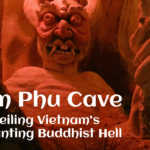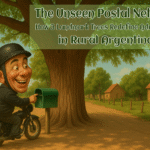Below Seattle’s bustling Pike Place Market, you’ll discover a truly unique and unconventional attraction: the Seattle Gum Wall. Descend into an unassuming alleyway and find yourself facing brick walls entirely covered in vibrant, multi-colored wads of chewed gum. Far from an accidental mess, this landmark stands as a fascinating testament to collective spontaneity, drawing visitors worldwide who often react with a mix of fascination and understandable disgust.
Navigating to Seattle’s Unique Attraction: Location and How to Visit
For those exploring Pike Place Market, discovering this sticky wonder is relatively straightforward. The Seattle Gum Wall resides in Post Alley, situated below the main market level. This iconic spot stands out as a truly unique and unconventional Seattle tourist attraction.
A helpful starting point is the market’s famous “Public Market Center” clock sign. To find this one-of-a-kind landmark, visitors should head down a ramp located to the left of this iconic sign. At the bottom of the ramp, a left turn into Post Alley will reveal the Gum Wall stretching along both sides of the passageway.
For those using GPS, the address is 1428 Post Alley, Seattle, WA 98101. The Gum Wall is adjacent to the Market Theater, now known as Unexpected Productions, which played a pivotal role in its creation. It’s also located near Pike Street, just south of the market’s primary entrance off 1st Avenue.
Nearby attractions include the Original Selfie Museum and Waterfront Park, offering additional points of reference for visitors. The Gum Wall’s slightly hidden location, tucked away from the main thoroughfare of the market, contributes to its unique appeal as a “hidden work of art,” inviting a sense of discovery for those who venture to find it.
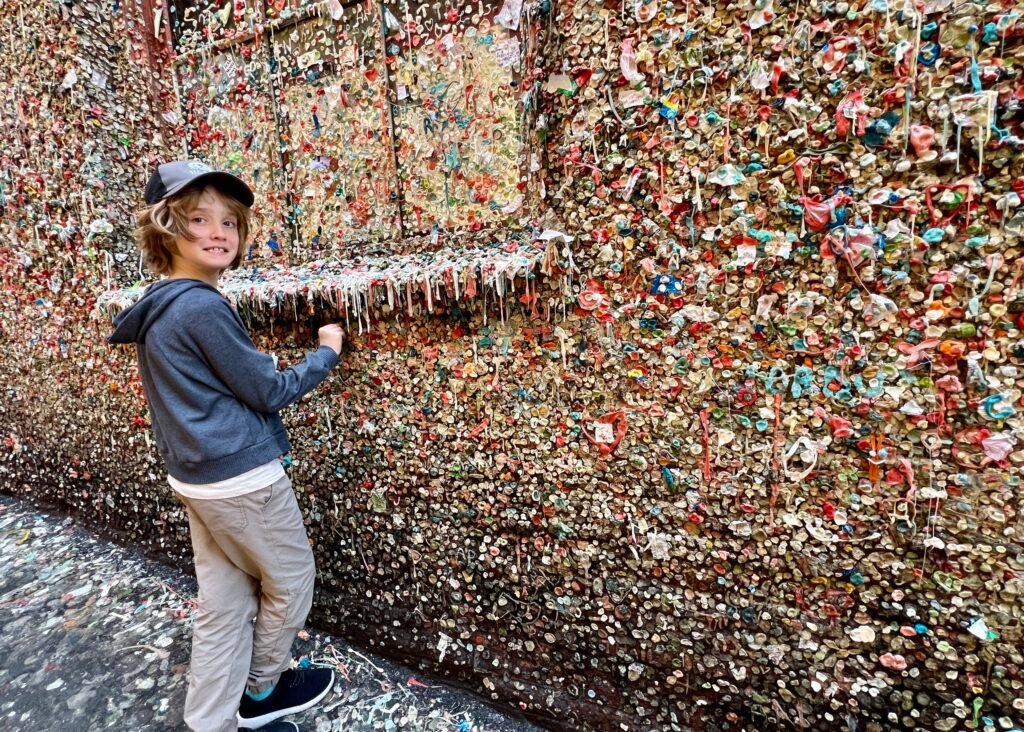
The Sweet History: How the Seattle Gum Wall Began
The story of the Gum Wall Seattle history dates back to the early 1990s. In May 1991, the improv group Unexpected Productions established its permanent home at the Market Theater in Post Alley. As patrons lined up outside, waiting for shows like the popular Theatresports, a quirky tradition spontaneously emerged. Instead of discarding their used chewing gum, theatergoers began sticking it to the brick wall.
Initially, many also pressed pennies into the wads of gum, creating what was known as a “penny wall.” This practice lasted for about a year until the pennies mysteriously disappeared. In the early days, both theater staff and the Pike Place Market Preservation and Development Authority (PDA) attempted to clean the growing accumulation of gum. However, the sheer volume of contributions quickly overwhelmed these efforts.
The persistent stream of gum from theater patrons and market visitors led to a turning point. Around 1999, market officials decided to embrace the sticky phenomenon, finally recognizing it as a unique tourist attraction. This acceptance came after witnessing the public’s repeated efforts to rebuild the gum wall each time it was cleaned. The Gum Wall’s origin was, therefore, an unintentional and organic development, evolving from a seemingly minor act into a significant landmark.
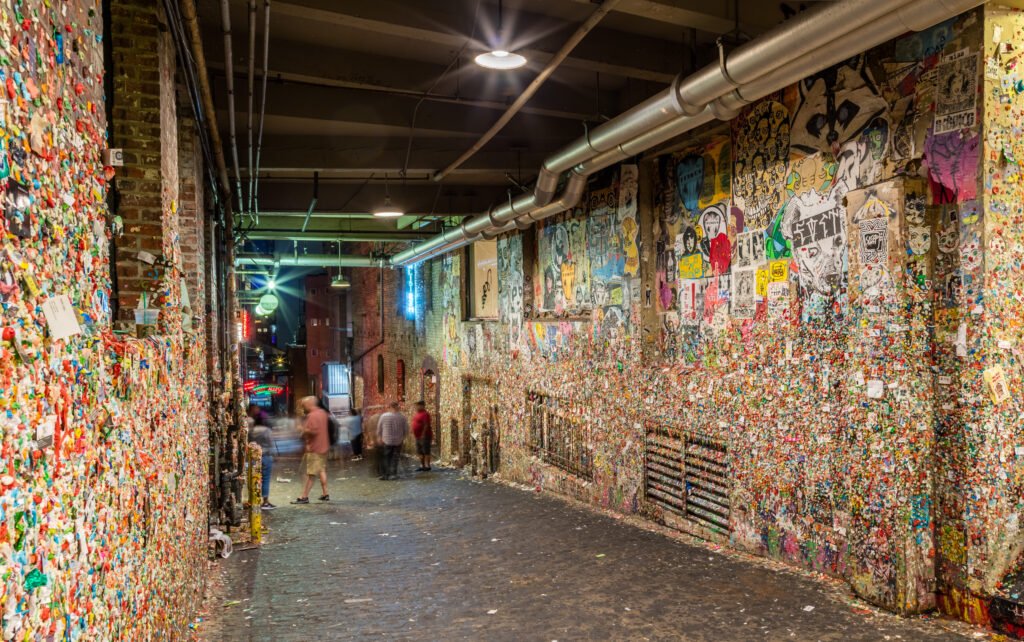
The Pike Place Market Gum Wall: More Than Just Mess
The Seattle Gum Wall sparks ongoing debate about its artistic merit. Many view it as a form of “collective art,” a community-driven project representing spontaneity and shared expression, with some even classifying it as “street art.” Visitors often go beyond simply sticking their gum; they creatively arrange it to form designs, spell out names, and craft small sculptures, sometimes leaving messages of hope and peace.
This perspective contrasts sharply with those who consider the Gum Wall mere littering or a “monstrosity,” with some locals expressing feelings of disgust and embarrassment. Despite these differing opinions, the Gum Wall is often seen as embodying Seattle’s “unique charm and character” and its “quirky spirit.” The former governor of Washington, Jay Inslee, even declared it his “favorite thing about Seattle.”
The Gum Wall has drawn comparisons to other unusual landmarks. Its function as a place for declarations of love, often expressed through gum formations, has led to comparisons with the Pont des Arts in Paris. Conversely, its reputation as a germ-ridden site has linked it to Ireland’s Blarney Stone. The Gum Wall has also found its way into popular culture, notably as a backdrop for wedding photos and in the 2009 film “Love Happens,” starring Jennifer Aniston and Aaron Eckhart, which significantly boosted its fame.
A Sticky Situation: The Visitor Experience
Visiting the Post Alley Gum Wall is a truly unique sensory experience. The first thing that strikes most visitors is the sheer volume and vibrant array of colors – a “kaleidoscope of colors and hues” – as chewed gum covers both sides of the alley. The air often carries a noticeable bubblegum aroma, though some might find it more akin to the “stench of decaying and aged chewing gum,” especially on warmer days.
For many, a visit isn’t complete without participating in the tradition of adding their own chewed gum to the wall, considered a “right of passage.” Nearby shops even sell gum for this purpose. Beyond the simple act of sticking gum, visitors often engage in creating gum sculptures and artistic arrangements, forming names, hearts, peace signs, and even leaving political statements or personal notes.
The Gum Wall is also a highly popular spot for taking photographs and selfies, a testament to its unique and visually striking nature. The sensory experience is a key element, with the vibrant colors and the distinctive, if sometimes debated, bubblegum aroma.
The act of adding one’s own gum fosters a sense of participation and connection to this ever-evolving landmark. Beyond the seemingly random accumulation, intentional artistic expressions emerge, showcasing individual creativity within the collective.
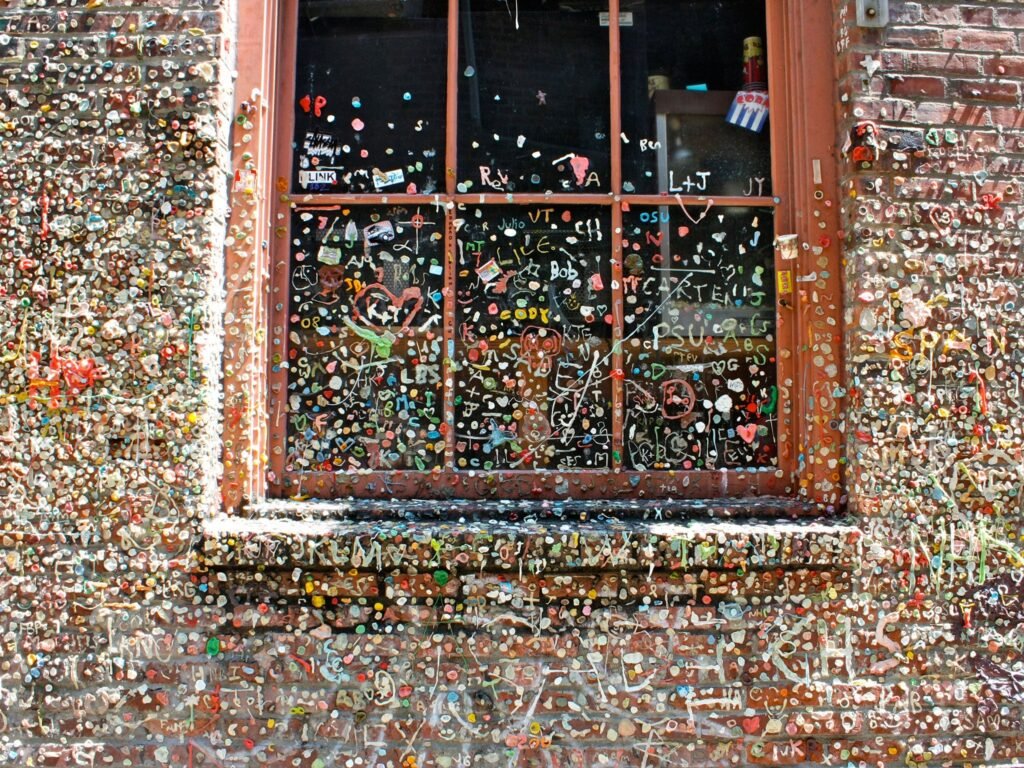
The Germ Factor: Hygiene Concerns and Controversies
The Seattle Gum Wall has earned a reputation as one of the “germiest” tourist attractions in the world. In 2009, it was ranked second only to the Blarney Stone in Ireland in terms of germ count. The accumulation of saliva-coated chewing gum naturally raises significant hygiene concerns. There have also been complaints about gum being tracked into nearby businesses and the attraction of rats to the alley. Bars and restaurants in the vicinity have even displayed “No Gum” signs in an attempt to protect their properties, though these efforts have proven largely ineffective.
Public opinion on the Gum Wall is sharply divided. Many visitors and locals find the concept “gross” and an “embarrassment,” while others embrace its quirkiness and unique artistic expression. Some even find a strange “grotesque beauty” in the sheer volume and variety of the gum. The “germiest” label, while deterring to some, has ironically contributed to the Seattle Gum Wall’s fame, attracting those with a taste for the unusual. The hygiene concerns have created practical problems for nearby businesses and market authorities, necessitating a balance between the wall’s popularity and maintaining a clean environment. The divided public opinion highlights the polarizing nature of this landmark, eliciting strong reactions ranging from revulsion to fascination.
Scrubbing the Canvas: The History of Gum Wall Cleaning
Over the years, Seattle’s iconic Gum Wall has gone through several cleanings. Back in the mid-to-late 1990s, the staff of the Market Theater attempted, albeit unsuccessfully, to remove the rapidly growing collection of chewed gum. However, more extensive cleaning efforts came later. The first full-scale cleaning in over two decades took place in November 2015, requiring 130 labor-intensive hours and resulting in the removal of more than 2,350 pounds (1,070 kg) of gum.
The operation, which cost approximately $4,000, was handled by Cascadian Building Maintenance. Officials explained that the main motivation behind the cleaning was to protect the historic brick walls from damage caused by the sugar and chemicals in the gum. Steam cleaning—reaching temperatures as high as 280 °F—and high-pressure washing were used to delaminate the gum. Workers also employed scrapers and rakes to handle the thicker, older layers.
Despite such efforts, the sticky surface of the Gum Wall never stays bare for long. Following the most recent cleaning in November 2024, a full new layer reappeared in less than a week. After the 2015 cleaning, one of the earliest new gum additions was a tribute to the Paris attacks. This rapid return illustrates not just the public’s strong emotional connection to the wall, but also the inevitability of its continuous recreation. As noted by The Seattle Times, the cleaning now focuses less on aesthetics and more on preserving the underlying brick structure, highlighting the immense and ongoing scale of this peculiar urban landmark.
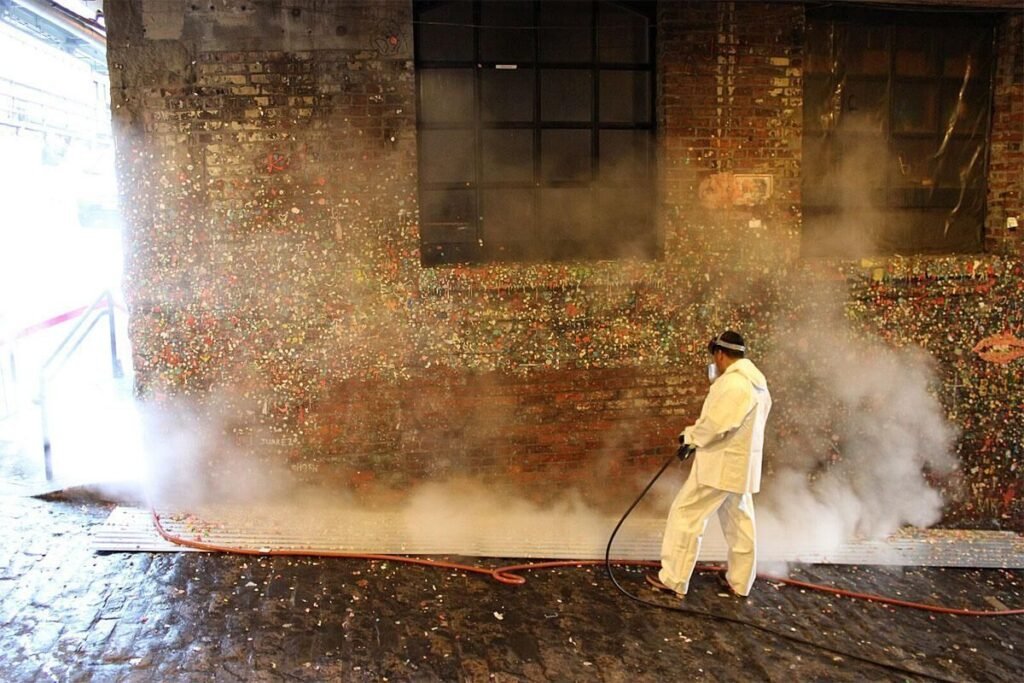
Seattle Gum Wall Cleaning History
| Cleaning Date | Reason for Cleaning | Method(s) Used | Amount of Gum Removed (approx.) | Duration |
| Mid-Late 1990s | Attempts to maintain cleanliness | Scraping | Unknown | Intermittent |
| November 2015 | Prevent brick erosion due to sugar | Steam cleaning, scraping | 2,350 pounds (1,070 kg) | 130 hours |
| September 2018 | General maintenance, prevent brick damage | Unknown | Unknown | Unknown |
| November 2024 | General maintenance, prevent brick damage | Pressure washing, potentially steam | Unknown | 5 days |
Dimensions of Delight (and Disgust): Size and Notable Features
The Seattle Gum Wall currently stretches approximately 54 feet (16 m) in length and reaches a height of about 8 feet (2.4 m). While earlier measurements indicated heights of up to 15 feet, in some areas, the gum accumulation is several inches thick, creating a truly remarkable texture on the Pike Place Market.
Over time, visitors have gone beyond simply sticking gum, creating various patterns and small works of art. These include spelling out names, forming hearts and peace signs. Notably, in January 2024, a local artist even created a mural of former Seattle Seahawks coach Pete Carroll using 200 pieces of chewed gum. Beyond intentional designs, visitors also tuck in personal mementos like graduation cards and wedding photos. Estimates suggest that hundreds of thousands, if not millions, of pieces of gum adorn the wall, with one estimate suggesting a density of around 180 pieces of gum per brick. The sheer scale and density of this gum coverage create a visually striking and somewhat overwhelming spectacle, where individual creativity meets collective contribution.
Why the Fuss? The Seattle Gum Wall as a Tourist Attraction
The Seattle Gum Wall’s enduring popularity as a tourist attraction stems from a confluence of factors. Its sheer uniqueness and unusual nature set it apart from typical landmarks, offering a memorable and slightly bizarre experience. Its prime location within the bustling Pike Place Market makes it easily accessible to the throngs of visitors already exploring the area.
The interactive element of adding one’s own chewed gum allows visitors to “leave their mark” and become part of the attraction’s ongoing narrative. It has also become a popular spot for quirky photo opportunities, with visitors eager to capture the colorful and unusual scene for social media. The Gum Wall has become intertwined with Seattle’s identity, representing its eccentric culture and “playful spirit,” making it a must-see for those seeking an authentic Seattle experience. Word-of-mouth and its prominent presence on social media have further amplified its reach, establishing it as an internationally recognized attraction.
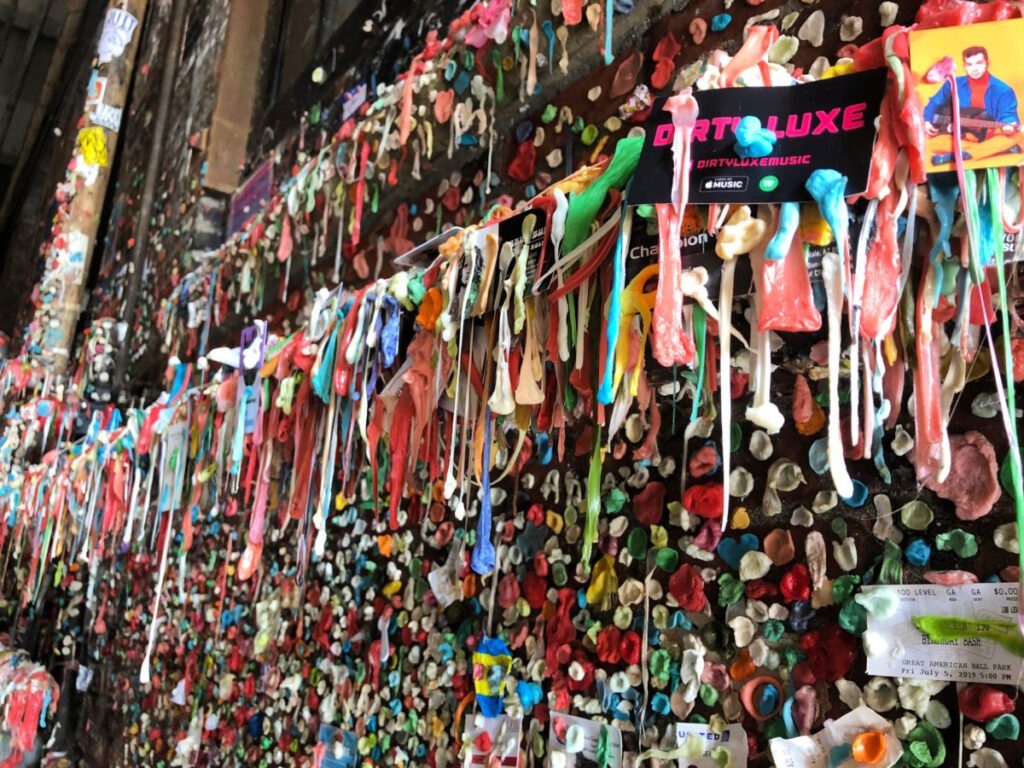
Conclusion: A Lasting (and Sticky) Legacy
The Seattle Gum Wall stands as a testament to the unexpected and often bizarre attractions that can capture the public imagination. From its accidental beginnings outside a small theater to its current status as a global Seattle tourist attraction, the Gum Wall embodies a unique blend of community participation, artistic expression, and a healthy dose of the unconventional.
While opinions on its hygiene and aesthetic merit remain divided, its enduring presence in the heart of Pike Place Market underscores its significance as a symbol of Seattle’s quirky and resilient spirit. The cyclical nature of its cleaning and subsequent re-gumming highlights the strong public connection to this sticky phenomenon, suggesting that this monument to mastication will likely continue to fascinate and perhaps slightly repulse visitors for years to come. In a world often dominated by meticulously curated attractions, the Gum Wall offers a refreshing, if somewhat gooey, reminder of the beauty and oddity that can arise from spontaneous collective action.
📍Check out 🛣️ Google Street View below to see where it all happened.🧭
For more strange and thought-provoking stories, feel free to explore our blog section where we cover the world’s most bizarre happenings.



